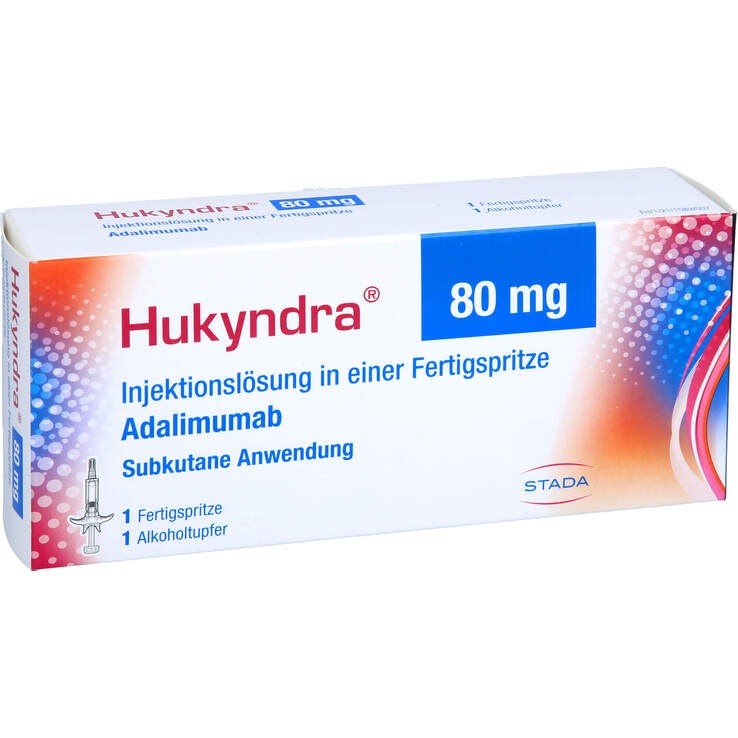
How to use HUKYNDRA 80 mg SOLUTION FOR INJECTION IN PRE-FILLED SYRINGE
Introduction
Package Leaflet: Information for the Patient
Hukyndra 80mg solution for injection in pre-filled syringe
adalimumab
- This medicinal product is subject to additional monitoring, which will allow quick identification of new safety information. You can help by reporting any side effects you may get. See the end of section 4 for how to report side effects.
Read all of this leaflet carefully before you start using this medicine, because it contains important information for you.
- Keep this leaflet, you may need to read it again.
- Your doctor will give you a patient information card, which contains important safety information that you need to know before you start using and during treatment with Hukyndra. Keep this patient information cardduring your treatment and for 4 months after your last injection of Hukyndra.
- If you have any further questions, ask your doctor or pharmacist.
- This medicine has been prescribed for you only. Do not pass it on to others. It may harm them, even if their signs of illness are the same as yours.
- If you get any side effects, talk to your doctor or pharmacist. This includes any possible side effects not listed in this leaflet. See section 4.
Contents of the pack and other information
- What is Hukyndra and what is it used for
- What you need to know before you use Hukyndra
- How to use Hukyndra
- Possible side effects
5 Storage of Hukyndra
- Contents of the pack and further information
- Instructions for use
1. What is Hukyndra and what is it used for
Hukyndra contains the active substance adalimumab.
Hukyndra is used to treat
- Rheumatoid arthritis
- Plaque psoriasis
- Hidradenitis suppurativa
- Crohn's disease
- Ulcerative colitis
- Non-infectious uveitis
The active substance in Hukyndra, adalimumab, is a human monoclonal antibody. Monoclonal antibodies are proteins that target specific targets.
The target of adalimumab is a protein called tumour necrosis factor (TNFα), which is involved in the immune system (defence) and is found in high levels in the inflammatory diseases described above. By targeting TNFα, Hukyndra reduces the inflammatory process in these diseases.
Rheumatoid arthritis
Rheumatoid arthritis is an inflammatory disease of the joints.
Hukyndra is used to treat moderate to severe rheumatoid arthritis in adults. You may have been given other medicines to modify the disease, such as methotrexate, before. If you do not respond well enough to these medicines, you will be given Hukyndra.
Hukyndra may also be used to treat severe, active and progressive rheumatoid arthritis without prior treatment with methotrexate.
Hukyndra can reduce joint damage caused by the inflammatory disease and can help you move more freely.
Your doctor will decide if Hukyndra should be used with methotrexate or alone.
Plaque psoriasis
Plaque psoriasis is a skin disease that causes red, scaly, crusty, and silvery-scaled areas. Plaque psoriasis can also affect the nails, causing them to deteriorate, thicken, and lift off the nail bed, which can be painful.
Hukyndra is used to treat moderate to severe chronic plaque psoriasis in adults.
Hidradenitis suppurativa
Hidradenitis suppurativa (also known as inverse acne) is a chronic and often painful inflammatory skin disease. Symptoms can include painful nodules (lumps) and abscesses (boils) that can ooze pus. It usually affects specific areas of the skin, such as under the breast, armpits, inner thighs, groin, and buttocks. There may also be scarring in the affected areas.
Hukyndra is used to treat
- moderate to severe hidradenitis suppurativa in adults and
- moderate to severe hidradenitis suppurativa in adolescents from 12 to 17 years.
Hukyndra can reduce the number of nodules and abscesses caused by the disease, and the pain that is usually associated with this disease. You may have received other medicines before. If you do not respond well enough to these medicines, you will be given Hukyndra.
Crohn's disease
Crohn's disease is an inflammatory disease of the digestive tract.
Hukyndra is used to treat
- moderate to severe Crohn's disease in adults and
- moderate to severe Crohn's disease in children and adolescents from 6 to 17 years.
You may have received other medicines before. If you do not respond well enough to these medicines, you will be given Hukyndra.
Ulcerative colitis
Ulcerative colitis is an inflammatory disease of the large intestine.
Hukyndra is used to treat
- moderate to severe ulcerative colitis in adults and
- moderate to severe ulcerative colitis in children and adolescents from 6 to 17 years.
You may have received other medicines before. If you do not respond well enough to these medicines, you will be given Hukyndra.
Non-infectious uveitis
Non-infectious uveitis is an inflammatory disease that affects certain parts of the eye.
Hukyndra is used to treat
- adults with non-infectious uveitis with inflammation that affects the back of the eye
- children from 2 years of age with chronic non-infectious uveitis with inflammation that affects the front of the eye
This inflammation can lead to decreased vision and/or the presence of floaters in the eye (black dots or thin lines that move across the field of vision). Hukyndra works by reducing this inflammation. You may have received other medicines before. If you do not respond well enough to these medicines, you will be given Hukyndra.
2. What you need to know before you use Hukyndra
Do not use Hukyndra:
- If you are allergic to adalimumab or any of the other ingredients of this medicine (listed in section 6).
- If you have active tuberculosis or other severe infections (see "Warnings and precautions"). If you have symptoms of any infection, such as fever, wounds, fatigue, dental problems, it is important that you inform your doctor.
- If you have moderate to severe heart failure. It is important that you tell your doctor if you have had or have any serious heart problems (see "Warnings and precautions").
Warnings and precautions
Consult your doctor or pharmacist before you start using Hukyndra.
Allergic reactions
- If you notice an allergic reaction with symptoms such as chest tightness, difficulty breathing, dizziness, swelling, or rash, stop using Hukyndra and contact your doctor immediately, as these reactions can be life-threatening.
Infections
- If you have any infection, including chronic infections, or a localized infection in any part of your body (such as an ulcer on your leg), consult your doctor before starting treatment with Hukyndra. If you are not sure, contact your doctor.
- With treatment with Hukyndra, you may be more likely to get infections. This risk may be higher if you have damaged lungs. These infections can be serious and include:
- tuberculosis
- infections caused by viruses, fungi, parasites, or bacteria
severe infection in the blood (sepsis)
In rare cases, these infections can be life-threatening. For this reason, it is important that if you have symptoms such as fever, wounds, fatigue, or dental problems, you tell your doctor. Your doctor may decide to stop your treatment with Hukyndra for a while.
- Tell your doctor if you live in or travel to areas where fungal infections (such as histoplasmosis, coccidioidomycosis, or blastomycosis) are common.
- Tell your doctor if you have had recurrent infections or other diseases that increase the risk of infection.
- If you are over 65 years old, you may be more likely to get infections during treatment with Hukyndra. You and your doctor should pay special attention to signs of infection while you are receiving treatment with Hukyndra. It is important that you tell your doctor if you have symptoms of infection, such as fever, wounds, fatigue, or dental problems.
Tuberculosis
- It is very important that you tell your doctor if you have ever had tuberculosis or if you have been in close contact with someone who has had it. If you have active tuberculosis, you must not use Hukyndra.
- Since cases of tuberculosis have been reported in patients treated with adalimumab, your doctor will examine you for signs or symptoms of tuberculosis before starting your treatment with Hukyndra. This will include a thorough medical examination, including your medical history and appropriate diagnostic tests (such as chest X-ray and tuberculin test). The performance and results of these tests should be recorded on your patient information card.
- Tuberculosis can develop during treatment, even if you have received treatment to prevent tuberculosis.
- If you develop symptoms of tuberculosis (such as persistent cough, weight loss, lack of energy, low-grade fever), or any other infection during or after treatment, contact your doctor immediately.
Hepatitis B
- Tell your doctor if you are a carrier of the hepatitis B virus (HBV), if you have had active HBV infection, or if you think you may be at risk of getting HBV.
- Your doctor should perform a test for HBV. In people who are carriers of HBV, adalimumab may cause the virus to become active again.
- In rare cases, especially if you are taking other medicines that suppress the immune system, the reactivation of HBV can be life-threatening.
Surgery or dental intervention
- If you are going to have surgery or dental treatment, tell your doctor that you are taking Hukyndra. Your doctor may recommend that you temporarily stop treatment with Hukyndra.
Demyelinating disease
- If you have or develop a demyelinating disease (a disease that affects the insulation layer around the nerves, such as multiple sclerosis), your doctor will decide if you should be treated or continue treatment with Hukyndra. Tell your doctor immediately if you experience symptoms such as changes in vision, weakness in arms or legs, or numbness or tingling in any part of your body.
Vaccines
- Certain vaccines may cause infections and should not be given if you are being treated with Hukyndra.
- Consult your doctor before receiving any vaccine.
- If possible, it is recommended that children receive all scheduled vaccinations for their age before starting treatment with Hukyndra.
- If you received Hukyndra while you were pregnant, your baby may have a higher risk of getting infections during the first 5 months after birth. It is important that you inform your doctor and other healthcare professionals about the use of Hukyndra during pregnancy before your baby receives any vaccine. For more information on vaccines, see the section "Warnings and precautions".
Heart failure
- If you have mild heart failure and are being treated with Hukyndra, you may be closely monitored by your doctor. It is important that you tell your doctor if you have had or have any serious heart problems. If you develop new symptoms or your symptoms worsen (difficulty breathing, or swelling of your feet), you should contact your doctor immediately. Your doctor will decide if you should continue taking Hukyndra.
Fever, bruising, bleeding, or pale appearance
- In some patients, the body may not be able to produce enough of the type of blood cells that help the body fight infections or stop bleeding. Your doctor may decide to stop your treatment. If you develop persistent fever, easy bruising, or bleeding, or if you look pale, call your doctor immediately.
Cancer
- In very rare cases, certain types of cancer have been reported in children and adults treated with adalimumab or other TNF blockers.
- People with rheumatoid arthritis who have had the disease for a long time may have a higher than average risk of developing lymphoma (a cancer that affects the immune system) and leukaemia (a cancer that affects the blood and bone marrow).
- If you are being treated with Hukyndra, your risk of getting lymphoma, leukaemia, or other types of cancer may increase. A rare and serious type of lymphoma has been observed in patients treated with adalimumab. Some of these patients were also treated with azathioprine or 6-mercaptopurine.
- Tell your doctor if you are taking azathioprine or 6-mercaptopurine with Hukyndra.
- Cases of non-melanoma skin cancer have been observed in patients using adalimumab.
- Tell your doctor if new skin lesions appear or if existing lesions change during or after treatment.
- Cancers, other than lymphoma, have been reported in patients with a certain lung disease, called Chronic Obstructive Pulmonary Disease (COPD), treated with another TNF blocker. If you have COPD, or if you smoke heavily, you should discuss with your doctor whether treatment with a TNF blocker is suitable for you.
Autoimmune disease
- In rare cases, treatment with Hukyndra may cause a condition similar to lupus. Contact your doctor if you have symptoms such as unexplained persistent rash, fever, joint pain, or fatigue.
Children and adolescents
- Vaccines: if possible, your child should be up-to-date with all vaccinations before using Hukyndra.
Other medicines and Hukyndra
Tell your doctor or pharmacist if you are taking, have recently taken, or might take any other medicines.
You must not use Hukyndra with medicines that contain the following active substances, due to an increased risk of serious infections:
- Anakinra
- Abatacept.
Hukyndra can be taken with:
- Methotrexate
- Certain disease-modifying anti-rheumatic drugs (such as sulfasalazine, hydroxychloroquine, leflunomide, and injectable gold salts)
- Corticosteroids or painkillers, including non-steroidal anti-inflammatory drugs (NSAIDs).
If you are unsure, consult your doctor.
Pregnancy and breastfeeding
- You should consider using adequate contraceptive methods to avoid becoming pregnant and continue using them for at least 5 months after the last treatment with Hukyndra.
- If you are pregnant or think you may be pregnant, consult your doctor before using this medicine.
- Hukyndra should only be used during pregnancy if necessary.
- According to a pregnancy study, there was no higher risk of congenital defects when the mother had received treatment with adalimumab during pregnancy compared to mothers with the same disease who did not receive treatment with adalimumab.
- Hukyndra can be used during breastfeeding.
- If you use Hukyndra while you are pregnant, your baby may have a higher risk of getting infections.
- It is important that you inform the paediatrician and other healthcare professionals about the use of Hukyndra during pregnancy before your baby receives any vaccine. For more information on vaccines, see the section "Warnings and precautions".
Driving and using machines
The influence of Hukyndra on the ability to drive, cycle, or use machines is small. You may experience dizziness and vision disturbances after using Hukyndra.
Hukyndra contains sodium
This medicine contains less than 1 mmol of sodium (23 mg) per 0.8 ml; this is essentially "sodium-free".
3. How to use Hukyndra
Follow your doctor's administration instructions for this medication exactly. If in doubt, consult your doctor again.
The recommended doses of Hukyndra for each of its authorized uses are shown in the following table. Your doctor may prescribe a different presentation of Hukyndra if you need a different dose.
Rheumatoid Arthritis | ||
Age or Body Weight | How much and how often to take | Notes |
Adults | 40 mg every other week | In rheumatoid arthritis, continue treatment with methotrexate during the use of Hukyndra. If your doctor decides that methotrexate is inappropriate, Hukyndra may be administered as monotherapy. If you have rheumatoid arthritis and are not receiving methotrexate with your Hukyndra treatment, your doctor may decide to administer 40 mg of Hukyndra every week or 80 mg every two weeks. |
Plaque Psoriasis | ||
Age or Body Weight | How much and how often to take | Notes |
Adults | The initial dose is 80 mg (one 80 mg injection), followed by 40 mg every other week starting one week after the first dose. | If you get an inadequate response, your doctor may increase your dose to 40 mg weekly or 80 mg every two weeks. |
Hiddenitis Suppurativa | ||
Age or Body Weight | How much and how often to take | Notes |
Adults | The initial dose is 160 mg (two 80 mg injections on the same day or one 80 mg injection per day for two consecutive days), followed by an 80 mg dose (one 80 mg injection) two weeks later. After two more weeks, continue with a 40 mg dose every week or 80 mg every two weeks, as prescribed by your doctor. | It is recommended to use a daily antiseptic liquid on the affected areas. |
Adolescents from 12 to 17 years old with a weight of 30 kg or more | The initial dose is 80 mg (one 80 mg injection), followed by 40 mg every other week starting one week later. | If you get an inadequate response, your doctor may increase your dose to 40 mg every week or 80 mg every two weeks. It is recommended to use a daily antiseptic liquid on the affected areas. |
Crohn's Disease | ||
Age or Body Weight | How much and how often to take | Notes |
Children, adolescents, and adults from 6 years old who weigh 40 kg or more | The initial dose is 80 mg (one 80 mg injection), followed by 40 mg two weeks later. If a faster response is needed, the doctor may prescribe an initial dose of 160 mg (two 80 mg injections on the same day or one 80 mg injection per day for two consecutive days), followed by 80 mg (one 80 mg injection) two weeks later. From then on, the usual dose is 40 mg every other week. | Your doctor may increase your dose to 40 mg every week or 80 mg every two weeks. |
Children and adolescents from 6 to 17 years old who weigh less than 40 kg | The Hukyndra 80 mg pre-filled syringe should not be used in children or adolescents with Crohn's disease and a weight below 40 kg, as it is not possible to administer doses lower than 80 mg. |
Ulcerative Colitis | ||
Age or Body Weight | How much and how often to take | Notes |
Adults | The initial dose is 160 mg (two 80 mg injections on the same day or one 80 mg injection per day for two consecutive days), followed by 80 mg (one 80 mg injection) two weeks later. From then on, the usual dose is 40 mg every other week. | Your doctor may increase your dose to 40 mg every week or 80 mg every two weeks. |
Children and adolescents from 6 years old with a weight below 40 kg | Initial dose of 80 mg (one 80 mg injection), followed by 40 mg (one 40 mg injection) two weeks later. From then on, the usual dose is 40 mg every other week. | You should continue using adalimumab at the usual dose, even after turning 18. |
Children and adolescents from 6 years old with a weight of 40 kg or more | Initial dose of 160 mg (two 80 mg injections on the same day or one 80 mg injection per day for two consecutive days), followed by 80 mg (one 80 mg injection) two weeks later. From then on, the usual dose is 80 mg every other week. | You should continue using adalimumab at the usual dose, even after turning 18. |
Non-Infectious Uveitis | ||
Age or Body Weight | How much and how often to take | Notes |
Adults | The initial dose is 80 mg (one 80 mg injection), followed by 40 mg every other week starting one week after the first dose. | Corticosteroids or other medications that affect the immune system can continue to be used during treatment with Hukyndra. Hukyndra can also be administered as monotherapy. |
Children and adolescents from 2 years old with a weight of 30 kg or more | 40 mg every other week | Your doctor may prescribe an initial dose of 80 mg that can be administered one week before starting the usual schedule of 40 mg every other week. It is recommended to use Hukyndra in combination with methotrexate. |
Form and Route of Administration
Hukyndra is injected under the skin (subcutaneously).
In section 7 "Instructions for use" you will find detailed instructions on how to inject Hukyndra.
If you use more Hukyndra than you should
If you accidentally inject Hukyndra more frequently than prescribed by your doctor or pharmacist, you should report it. Always carry the medicine box with you, even if it's empty.
If you forget to use Hukyndra
If you forget to administer an injection, you should inject the next dose of Hukyndra as soon as you remember. Then, you will administer the next dose as usual, as if you had not forgotten a dose.
If you stop treatment with Hukyndra
The decision to stop using Hukyndra should be discussed with your doctor. Your symptoms may return if you stop using Hukyndra.
If you have any other questions about the use of this medication, ask your doctor or pharmacist.
4. Possible Side Effects
Like all medicines, this medicine can cause side effects, although not everybody gets them. Most side effects are mild to moderate. However, some can be serious and require treatment. Side effects can appear at least up to 4 months after the last injection of Hukyndra.
Contact your doctor immediately if you notice any of the following side effects
- severe rash, hives, or other signs of allergic reaction
- swelling of the face, hands, feet
- difficulty breathing, swallowing
- shortness of breath with physical activity or when lying down or swelling of feet
Contact your doctor as soon as possible if you notice any of the following side effects
- signs of infection such as fever, nausea, wounds, dental problems, burning sensation when urinating
- feeling of weakness or fatigue
- cough
- tingling
- numbness
- double vision
- weakness in arms or legs
- a lump or an open wound that does not heal
- signs and symptoms of blood disorders such as persistent fever, bruising, bleeding, pallor
The symptoms described above may be signs of the following side effects, which have been observed with adalimumab:
Very Common(may affect more than 1 in 10 people)
- reactions at the injection site (including pain, swelling, redness, or itching)
- respiratory tract infections (including colds, runny nose, sinusitis, pneumonia)
- headache
- abdominal pain
- nausea and vomiting
- rash
- muscle pain
Common(may affect up to 1 in 10 people)
- serious infections (including sepsis and flu)
- intestinal infections (including gastroenteritis)
- skin infections (including cellulitis and herpes)
- ear infection
- oral infections (including dental infection and cold sore)
- infections of the reproductive system
- urinary tract infections
- fungal infections
- joint infections
- benign tumors
- skin cancer
- allergic reactions (including seasonal allergy)
- dehydration
- mood changes (including depression)
- anxiety
- difficulty sleeping
- sensory disturbances such as tingling, itching, or numbness
- migraine
- nerve root compression (including lower back pain and leg pain)
- visual disturbances
- eye inflammation
- eyelid inflammation and eye swelling
- vertigo (feeling of dizziness or spinning)
- feeling of rapid heartbeat
- high blood pressure
- flushing
- hematomas (blood accumulation outside blood vessels)
- cough
- wheezing
- difficulty breathing
- gastrointestinal bleeding
- indigestion (indigestion, bloating, and heartburn)
- acid reflux
- dry eye syndrome (including dryness in eyes and mouth)
- itching
- itchy rash
- bruising
- skin inflammation (such as eczema)
- breaking of fingernails and toenails
- increased sweating
- hair loss
- new onset or worsening of existing psoriasis
- muscle spasms
- blood in urine
- kidney problems
- chest pain
- edema (swelling)
- fever
- decrease in platelet count in blood, which increases the risk of bleeding or bruising
- wound healing problems
Uncommon(may affect up to 1 in 100 people)
- opportunistic infections (including tuberculosis and other infections that occur when disease resistance decreases)
- neurological infections (including viral meningitis)
- eye infections
- bacterial infections
- diverticulitis (inflammation and infection of the large intestine)
- cancer
- cancer affecting the lymphatic system
- melanoma
- immunological disorders that can affect the lungs, skin, and lymph nodes (the most common presentation is sarcoidosis)
- vasculitis (inflammation of blood vessels)
- tremor (feeling shaky)
- neuropathy (disorder of the nervous system)
- stroke
- hearing loss, tinnitus
- feeling of irregular heartbeat like skips
- heart problems that can cause difficulty breathing or swelling of ankles
- heart attack
- aneurysm of a major artery, inflammation, and clotting in a vein, blockage of a blood vessel
- pulmonary diseases that can cause difficulty breathing (including inflammation)
- pulmonary embolism (blockage of a pulmonary artery)
- pleural effusion (abnormal fluid accumulation in the pleural space)
- pancreatitis that causes severe abdominal and back pain
- difficulty swallowing
- facial edema (swelling of the face)
- inflammation of the gallbladder; gallstones
- fatty liver
- night sweats
- scars
- abnormal muscle crisis
- systemic lupus erythematosus (including skin inflammation, heart, lungs, joints, and other organs)
- sleep disturbances
- impotence
- inflammations
Rare(may affect up to 1 in 1000 people)
- leukemia (cancer that affects blood and bone marrow)
- severe allergic reaction with shock
- multiple sclerosis
- nerve disorders (such as optic neuritis and Guillain-Barré syndrome that can cause muscle weakness, abnormal sensations, tingling in arms and upper body)
- cardiac arrest
- pulmonary fibrosis (scarring in the lungs)
- intestinal perforation (hole in the intestine)
- hepatitis
- reactivation of hepatitis B virus
- autoimmune hepatitis (liver inflammation caused by the body's own immune system)
- cutaneous vasculitis (inflammation of blood vessels in the skin)
- Stevens-Johnson syndrome (early symptoms include discomfort, fever, headache, and rash)
- facial edema (swelling of the face) associated with allergic reactions
- erythema multiforme (inflammatory rash on the skin)
- lupus-like syndrome
- angioedema (localized skin inflammation)
- lichenoid skin reaction (purple-red rash with itching)
Frequency Not Known(cannot be estimated from the available data)
- hepatosplenic T-cell lymphoma (a rare and often fatal blood cancer)
- Merkel cell carcinoma (a type of skin cancer)
- Kaposi's sarcoma, a rare cancer related to human herpesvirus 8 infection. Kaposi's sarcoma usually occurs more frequently as purple skin lesions.
- liver failure
- worsening of a disease called dermatomyositis (seen as skin rash accompanied by muscle weakness)
- weight gain (for most patients, weight gain was reduced)
Some side effects observed with adalimumab may not have symptoms and can only be identified through a blood test. These include:
Very Common(may affect more than 1 in 10 people)
- low white blood cell count
- low red blood cell count
- increased lipids in blood
- increased liver enzymes
Common(may affect up to 1 in 10 people)
- high white blood cell count
- low platelet count
- increased uric acid in blood
- abnormal sodium levels in blood
- low calcium levels in blood
- low phosphate levels in blood
- high blood sugar
- high lactate dehydrogenase levels in blood
- presence of autoantibodies in blood
- low potassium levels in blood
Uncommon(may affect up to 1 in 100 people)
- high bilirubin levels (liver function test)
Rare(may affect up to 1 in 1000 people)
- low counts in blood for white blood cells, red blood cells, and platelets
Reporting of Side Effects
If you experience any side effects, consult your doctor or pharmacist, even if it is possible side effects not listed in this leaflet. You can also report them directly through the national reporting system included in Appendix V. By reporting side effects, you can help provide more information on the safety of this medicine.
5. Storage of Hukyndra
Keep this medicine out of the sight and reach of children.
Do not use this medicine after the expiry date which is stated on the label and on the carton after “EXP”. The expiry date is the last day of the month shown.
Store in a refrigerator (between 2°C and 8°C). Do not freeze.
Keep the pre-filled syringe in the outer packaging to protect it from light.
Alternative storage:
When necessary (e.g., when traveling), you can store a single Hukyndra pre-filled syringe at 20°C to 25°C for a maximum period of 30 days (make sure to protect it from light). Once you have removed the syringe from the refrigerator to store it at 20°C to 25°C, you must use it within the next 30 days or discard it, even if you put it back in the refrigerator.
You should note the date you removed the syringe from the refrigerator and the date after which you must discard the syringe.
Do not use this medicine if the liquid is cloudy, discolored, or contains flakes or particles.
Medicines should not be disposed of via wastewater or household waste. Ask your doctor or pharmacist how to dispose of the packaging and any unused medicine. This will help protect the environment.
6. Container Contents and Additional Information
Composition of Hukyndra
- The active ingredient is adalimumab.
- The other components are: sodium chloride, sucrose, polysorbate 80, water for injectable preparations, hydrochloric acid (for pH adjustment), sodium hydroxide (for pH adjustment).
Appearance of Hukyndra and Container Contents
Hukyndra 80 mg injectable solution in a pre-filled syringe with a needle protector is supplied as a sterile solution of 80 mg of adalimumab dissolved in 0.8 ml of solution.
The Hukyndra pre-filled syringe is a glass syringe containing an adalimumab solution.
Each container contains 1 pre-filled syringe packaged in a blister pack, with an alcohol swab.
Marketing Authorization Holder
STADA Arzneimittel AG
Stadastrasse 2-18
61118 Bad Vilbel
Germany
Manufacturers
Ivers-Lee CSM
Marie-Curie-Str.8
79539 Lörrach
Germany
Alvotech Hf
Sæmundargata 15-19
Reykjavik, 101
Iceland
STADA Arzneimittel AG
Stadastrasse 2-18
61118 Bad Vilbel
Germany
You can request more information about this medication by contacting the local representative of the marketing authorization holder:
Belgium/Belgique/Belgien EG (Eurogenerics) NV Tel: +32 24797878 | Lithuania UAB „STADA Baltics“ Tel: +370 52603926 |
| Luxembourg/Luxemburg EG (Eurogenerics) NV Tel: +32 4797878 |
Czech Republic STADA PHARMA CZ s.r.o. Tel: +420 257888111 | Hungary STADA Hungary Kft Tel.: +36 18009747 |
Denmark STADA Nordic ApS Tlf: +45 44859999 | Malta Pharma.MT Ltd Tel: +356 21337008 |
Germany STADAPHARM GmbH Tel: +49 61016030 | Netherlands Centrafarm B.V. Tel.: +31 765081000 |
Estonia UAB „STADA Baltics“ Tel: +370 52603926 | Norway STADA Nordic ApS Tlf: +45 44859999 |
Greece STADA Arzneimittel AG Tel: +30 2106664667 | Austria STADA Arzneimittel GmbH Tel: +43 136785850 |
Spain Laboratorio STADA, S.L. Tel: +34 934738889 | Poland STADA Poland Sp. z.o o. Tel: +48 227377920 |
France EG LABO - Laboratoires EuroGenerics Tel: +33 146948686 | Portugal Stada, Lda. Tel: +351 211209870 |
Croatia STADA d.o.o. Tel: +385 13764111 | Romania STADA M&D SRL Tel: +40 213160640 |
Ireland Clonmel Healthcare Ltd. Tel: +353 526177777 | Slovenia Stada d.o.o. Tel: +386 15896710 |
Iceland STADA Arzneimittel AG Tel: +49 61016030 | Slovak Republic STADA PHARMA Slovakia, s.r.o. Tel: +421 252621933 |
Italy EG SpA Tel: +39 028310371 | Finland STADA Nordic ApS, Finnish branch Tel: +358 207416888 |
Cyprus STADA Arzneimittel AG Tel: +30 2106664667 | Sweden STADA Nordic ApS Tel: +45 44859999 |
Latvia UAB „STADA Baltics“ Tel: +370 52603926 | United Kingdom (Northern Ireland) STADA Arzneimittel AG Tel: +49 61016030 |
Date of the Last Revision of this Leaflet
Other Sources of Information
Detailed information about this medication is available on the European Medicines Agency website: http://www.ema.europa.eu.
You can access detailed and updated information about this medication, including a video on how to use the pre-filled pen, by scanning the QR code included below or on the outer packaging with your smartphone. You can also access this information at the following internet address: hukyndrapatients.com
Include QR code
- Instructions for Use
INSTRUCTIONS FOR USE
Hukyndra (adalimumab) pre-filled syringe
80 mg/0.8 ml solution for subcutaneous injection
Read these instructions for use carefully before using Hukyndra pre-filled syringe for single use
Hukyndra pre-filled syringe


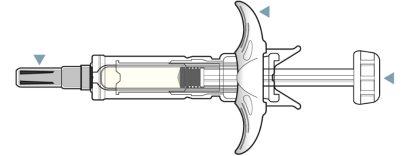
Important Information You Need to Know Before Injecting Hukyndra Pre-filled Syringe for Single Use
Important Information:
- For subcutaneous injection only
- Do notuse the syringe and call your healthcare professional or pharmacist if:
- The liquid is cloudy, discolored, or has flakes or particles in it
- The expiration date has passed
- The liquid has been frozen (even if it has been thawed) or exposed to direct sunlight
- The pre-filled syringe has been dropped or crushed
- Keep the needle cap on until just before injection. Keep Hukyndra out of the reach of children.
- See section 5 of the leaflet for information on how to store Hukyndra pre-filled syringe for single use.
Before Injecting:
Your healthcare professional should show you how to use Hukyndra pre-filled syringe for single use before you use it for the first time.
Current Use of Adalimumab Syringe:
Even if you have used other adalimumab syringes on the market before, read the instructions completely so you understand how to use this device correctly before trying to inject yourself.
Do You Have Questions About Using the Hukyndra Pre-filled Syringe?
Talk to your healthcare professional if you have any questions.
Preparation for Injecting Hukyndra Pre-filled Syringe
STEP 1: Remove the Syringe from the Refrigerator and Let it Reach Room Temperature
1.1 Remove Hukyndra from the refrigerator (see Figure A).
1.2 Let Hukyndra reach room temperature (between 20°C and 25°C) for 15 to 30 minutes before injecting (see Figure B).
- Do notremove the gray needle cap while letting Hukyndra reach room temperature.
- Do notheat Hukyndra in any other way. For example, do notheat it in a microwave or with hot water.
- Do notuse the pre-filled syringe if the liquid has been frozen (even if it has been thawed).

Figure A


Figure B
STEP 2: Check the Expiration Date and the Medicinal Liquid
2.1 Check the expiration date on the pre-filled syringe label (see Figure C).
- Do notuse the pre-filled syringe if the expiration date (EXP) has passed.
2.2 Check the medicinal liquid in the syringe to make sure it is clear and colorless (Figure C).
- Do not use the syringe and call a healthcare professional or pharmacist if the liquid is cloudy, discolored, or has flakes or particles in it.


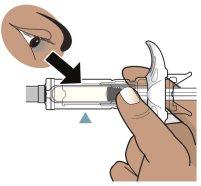
Figure C
STEP 3: Gather the Devices and Wash Your Hands
3.1 Place the following on a clean and flat surface (see Figure D):
- 1 pre-filled syringe for single use and an alcohol swab.
- 1 cotton ball or gauze (not included).
- A puncture-resistant sharps container (not included). See step 9.
3.2 Wash and dry your hands (see Figure E).


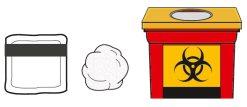
Figure D
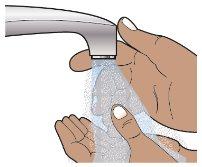
Figure E
Injecting Hukyndra Pre-filled Syringe
STEP 4: Choose and Clean the Injection Site
4.1 Choose an injection site (see Figure F):
- On the front of the thighs or,
- On the stomach (abdomen) at least 5 cm away from the navel.
- Different from your last injection site (at least 3 cm away from the last injection site).
4.2 Clean the injection site with a circular motion using the alcohol swab (see Figure G).
- Do not inject through clothing.
- Do not inject into painful, bruised, red, hard, scarred, or stretch-marked skin.
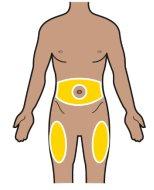
Figure F

Figure G
STEP 5: Remove the Needle Cap
5.1 Hold the pre-filled syringe with one hand (see Figure H).
5.2 Pull the needle cap straight off with the other hand (see Figure H).
- Dispose of the needle cap.
- Do not reuse it.
- Do not touch the needle with your fingers or let the needle touch anything.
- Hold the pre-filled syringe with the needle facing up. You may see air in the pre-filled syringe. Slowly push the plunger to push the air through the needle.
- You may see a drop of liquid at the end of the needle. This is normal.
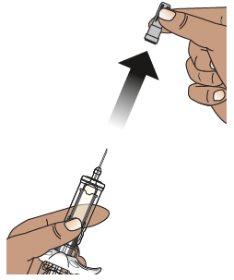
Figure H
STEP 6: Hold the Syringe and Pinch the Skin
6.1 Hold the body of the pre-filled syringe with one hand between the thumb and index finger, as if holding a pencil (see Figure I). Do not pull the plunger back at any time.
6.2 Gently pinch (squeeze) the clean skin at the injection site (abdomen or thigh) with the other hand (see Figure J). Hold the skin firmly.
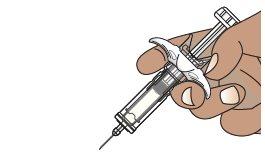
Figure I
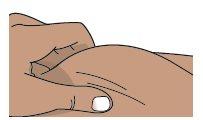
Figure J
STEP 7: Inject the Medication
7.1 Insert the needle into the pinched skin at an angle of about 45 degrees, with a quick motion, like a dart (see Figure K).
- Once the needle is in, release the skin.
7.2 Slowly push the plunger until all the liquid is injected, and the pre-filled syringe is empty (see Figure L).
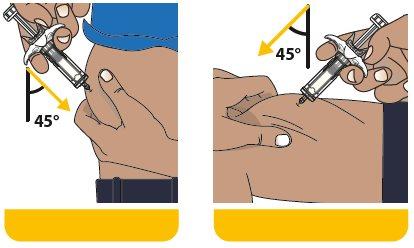
Figure K
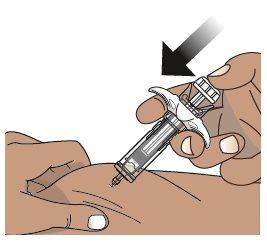
Figure L
STEP 8: Let the Pre-filled Syringe Withdraw the Needle from the Skin
8.1 Slowly lift your finger off the plunger. The plunger will move up with your finger and withdraw the needle from the site, inside the needle protector (see Figure M).
- The needle will not retract until all the liquid is injected. Consult your doctor, pharmacist, or nurse if you think you have not given a complete dose.
- It is normal to see a spring around the plunger rod after the needle retracts.
8.2 After completing the injection, place a cotton ball or gauze on the skin over the injection site.
- Do notrub.
- Mild bleeding at the injection site is normal.
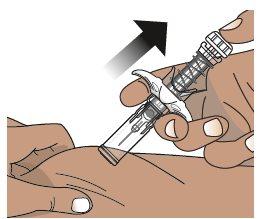
Figure M
Disposal of Hukyndra Pre-filled Syringe
STEP 9: Dispose of the Used Syringe in a Sharps Container
9.1 Place used needles, syringes, and sharps in a sharps container immediately after use (see Figure N).
- Do notthrow away loose needles and syringes in household trash
9.2 The needle cap, alcohol swab, cotton ball or gauze, and packaging can be thrown away in household trash.
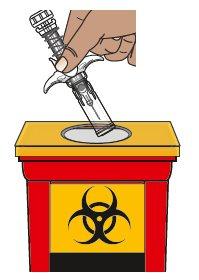
Figure N
Additional Information on Disposal
- If you do not have a sharps container, you can use a household container that is:
- made of heavy-duty plastic,
- can be closed with a tight-fitting, puncture-resistant lid, without the sharps being able to come out,
- upright and stable during use,
- leak-resistant and
- properly labeled to warn of hazardous waste inside the container.
When your sharps container is almost full, you should follow local guidelines for the proper disposal of your sharps container.
Do notdispose of your used sharps container in household trash. Do notrecycle your used sharps container.
If you have any questions, contact your healthcare professional for assistance.
- Country of registration
- Active substance
- Prescription requiredYes
- Manufacturer
- This information is for reference only and does not constitute medical advice. Always consult a licensed doctor before taking any medication. Oladoctor is not responsible for medical decisions based on this content.
- Alternatives to HUKYNDRA 80 mg SOLUTION FOR INJECTION IN PRE-FILLED SYRINGEDosage form: INJECTABLE, 20 mgActive substance: adalimumabManufacturer: Amgen Europe B.V.Prescription requiredDosage form: INJECTABLE, 20 mgActive substance: adalimumabManufacturer: Amgen Europe B.V.Prescription requiredDosage form: INJECTABLE, 40 mgActive substance: adalimumabManufacturer: Amgen Europe B.V.Prescription required
Alternatives to HUKYNDRA 80 mg SOLUTION FOR INJECTION IN PRE-FILLED SYRINGE in other countries
The best alternatives with the same active ingredient and therapeutic effect.
Alternative to HUKYNDRA 80 mg SOLUTION FOR INJECTION IN PRE-FILLED SYRINGE in Украина
Online doctors for HUKYNDRA 80 mg SOLUTION FOR INJECTION IN PRE-FILLED SYRINGE
Discuss dosage, side effects, interactions, contraindications, and prescription renewal for HUKYNDRA 80 mg SOLUTION FOR INJECTION IN PRE-FILLED SYRINGE – subject to medical assessment and local rules.



